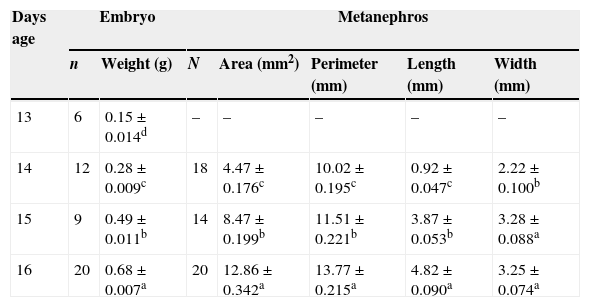Embryonic kidney xenotransplantation could represent a new solution to the scarcity of kidneys for transplantation.
ObjectiveTo determine the feasibility of allogeneic laparoscopic transplantation of metanephros (M) in rabbits.
Materials and methodsMicroscopic dissection was conducted to obtain metanephros from 14-day-old (24 M), 15-day-old (20 M) and 16-day-old (26 M) embryos. Using single-port abdominal laparoscopy, a spinal needle was inserted percutaneously, through which the metanephros were deposited (using an epidural catheter) close to a patent blood vessel in the retroperitoneal fat. Seventy metanephros were transplanted to 18 rabbits. Three weeks later, the animals were examined through open surgery. We compared the embryonic maturity, the morphometric variables of the metanephros and the development rate of the transplanted metanephros.
ResultsThe lower time limit for the extraction of metanephros from the rabbits was day 14. Three weeks after transplantation, only 3/24 14-day-old metanephros grew at minimal expression (12.5%). In contrast, 10/20 (50%) 15-day-old and 12/26 (46.1%) 16-day-old metanephros grew. These metanephros had differentiated sufficiently toward normal glomeruli, proximal and distal tubules and collecting ducts. We detected no relevant immunological changes in the peripheral blood.
ConclusionsWe have described for the first time in the literature the allogeneic laparoscopic transplantation of metanephros from embryos as a feasible and noninvasive technique. The recipients did not require immunosuppression.
Una solución novedosa a la escasez de riñones para trasplante puede ser el xenotrasplante de riñones embrionarios.
ObjetivoConocer la viabilidad del trasplante alogénico laparoscópico de metanefros (M) en conejos.
Material y métodoSe realizó disección microscópica para obtener metanefros en embriones de 14 días de edad (24 M), 15 (20 M) y 16 (26 M). Mediante laparoscopia abdominal de un puerto se insertó percutáneamente una aguja raquídea y por ella, mediante un catéter epidural, depositamos el metanefros cerca de un vaso sanguíneo patente en la grasa retroperitoneal. Setenta metanefros se trasplantaron a 18 conejos. Tres semanas después los animales fueron explorados por cirugía abierta. Se analizó la comparación de la madurez embrionaria, las variables morfométricas de los metanefros y la tasa de desarrollo de los metanefros trasplantados.
ResultadosEl límite temporal inferior para la extracción de metanefros en conejos es el día 14. Tres semanas postrasplante crecieron a una mínima expresión solo 3/24 M de 14 días (12,5%). Por el contrario, 10/20 (50%) de los de 15 días y 12/26 (46,1%) de los de 16 días de edad crecieron y se diferenciaron de tal manera que se habían desarrollado normalmente los glomérulos, túbulos proximales y distales y conductos colectores. No se detectaron cambios inmunológicos relevantes en sangre periférica.
ConclusionesDescribimos, por primera vez en la literatura, el trasplante laparoscópico alogénico de metanefros de embriones como una técnica factible y no invasiva. Los receptores no necesitaron inmunosupresión.












